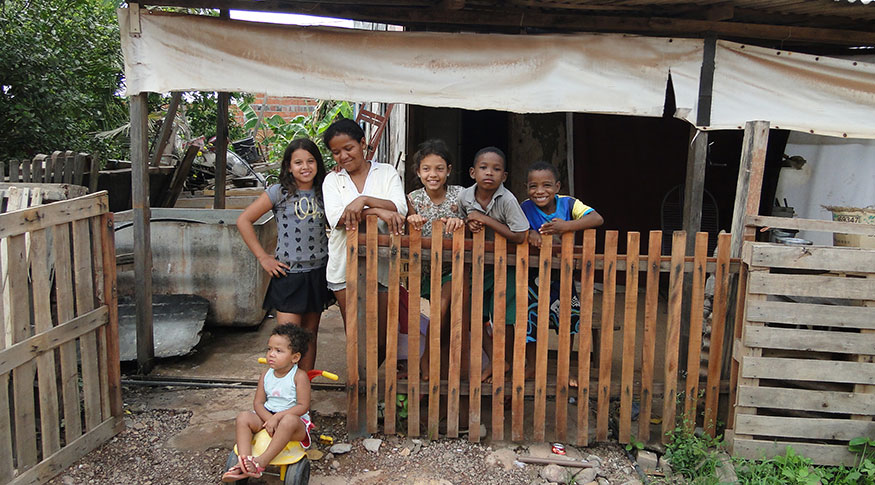Summary of Social Indicators
Labor, income and housing: inequalities between whites and blacks or browns go on in Brazil
November 12, 2020 10h00 AM | Last Updated: November 26, 2020 06h20 PM
Highlights
- One of the main indicators of the labor market, the unemployment rate was, in 2019, 9.3% for whites, and 13.6% for blacks or browns.
- In the employed population, the percentage of blacks or browns in informal occupations reached 47.4%, while among white workers it was 34.5%.
- The employed population of white color or race earned an average 73.4% more than blacks or browns. In current values, it meant a monthly labor income of R$ 2,884 compared to R$ 1,663.
- The hourly income of whites with higher education was R$ 33.90, while blacks and browns with the same level of education earned R$ 23.50 per hour worked.
- In the population below the poverty line, 70% were black or brown. Poverty affected black or brown women the most: 39.8% of the extremely poor and 38.1% of the poor.
- 45.2 million people lived in 14.2 million households with some sort of inadequacy. Of this population, 13.5 million were white and 31.3 million were black or brown people.

Labor market, income and housing conditions are uneven in the country according to the color and race of Brazilians. Based on data from Continuous PNAD 2019, the Summary of Social Indicators study, released today (12) by the IBGE, shows that blacks or browns have higher unemployment and informality rates than whites, are more present in the poverty and extreme poverty ranges and live more often in homes with some type of inadequacy.
One of the main indicators of the labor market, the unemployment rate was, in 2019, of 9.3%, for whites, and 13.6% for blacks or browns. Among employed persons, the percentage of blacks and browns in informal jobss achieved 47.4%, whereas the white share in informal jobs was of 34.5%. The result reflects the major participation of blacks and browns in informal works, as for example, agricultural activities, with 62.7% of blacks and browns, construction, with 65.2%, and household chores, with 66.6%.
“Informality among blacks or browns is a historical feature noticed every year in the Continuous PNAD time series, started in 2012 and closed in 2019. The group needs attention, is the most vulnerable group, with no rights for time retirement, paid leave due to disease or maternity leave, therefore, they are the most vulnerable in terms of employed persons”, explains the SIS coordinator, João Hallak.
The definition of informality used in the Summary is recommended by the International Labour Organization (ILO) and includes five categories of employment types: employed without a formal contract, domestic workers without a formal contract, self-employed without social security coverage, employer without social security coverage and contributing family worker.
This highest insertion of blacks and browns in the informal sector, as domestic workers without a formal contract, with average monthly income of R$ 755 in 2019, contributed to the reduction of the average income within this population group. The employed population that belongs to the white race/color group earned on average 73.4% more than the black or brown ones. In numbers, this means a monthly income of R$ 2,884 against R$ 1,663, in 2019.
The white employed population also received higher hours paid than the black or brown population whatever the schooling level, with a major difference in the complete higher education range, R$ 33.90 against R$ 23.59, which means 44.3% more for whites.
The Summary shows that extreme poverty in Brazil grew 13.5%, changing from 5.8% of the population, in 2012, to 6.5%, in 2019, according to the international line established by the World Bank at US$ 1.90 each day in terms of Purchasing Power Parity (PPC). In the line of US$ 5.50 PPC (poverty), it has reduced as the number of poor people by 6.6%, decreasing from 26.5% to 24.7% of the population, in this period. Among the self-declared whites, 3.4% were extremely poor and 14.7% were poor, but in relation to blacks or browns, those numbers more than double.
Among people under the World Bank poverty lines, 70% were black or brown people, whereas selfdeclared blacks or browns were 56.3% of the total population. Poverty affected mainly black or brown women: 28% of the population, but 39.8% of them were extremely poorand 38.1% of them, poor.
“The black or brown population is majority in the informal market, has less years of schooling, is more present at activities with lowest income; therefore, these factors contribute to a lower labor income. Certainly, all those elements, both in the labor market and out of the labor market, contribute to the lower per capita household income and to their relative insertion in the poverty and extreme poverty categories”, analyses Mr. Hallak.
Inequality also appears in the household indicators. The survey shows that 45.2 million people live in 14.2 million households with at least five inadequacies - no private bathroom, external walls with non-durable materials, high density of residents, high burden with rent and absence of ownership document. In this population, 13.5 million were white and 31.3 million were black or brown.
“It is not possible to choose just one indicator as the most important in terms of inequality. We notice a structural inequality throughout the time series in many indicators, and not only in 2019. I believe that the combined analysis of every data has the potential to depict inequality.”, concludes João Hallak.




















